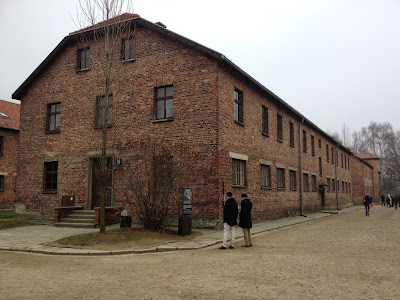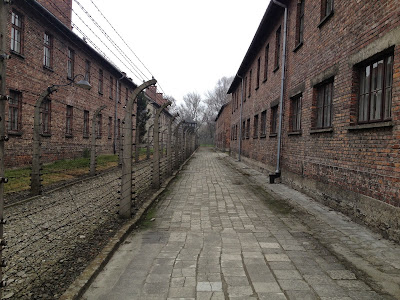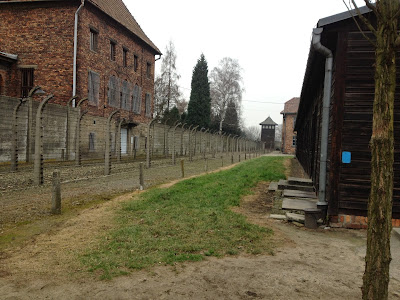I never knew this, but Auschwitz is actually comprised of 3 separate main camps and a handful of smaller satellite camps. In this trip, we toured Auschwitz I, which is the main camp, and Auschwitz II - Birkenau. Auschwitz III - Monowitz was a camp for laborers that were used by local companies.
I don't want to imply that anything about touring labor and extermination camps was happy, but there were a few good things about the tours:
1. I learned a lot. Seeing these camps might have been one of the more worthwhile things I've done.
2. Our tour guide was excellent. She answered all of our questions and she repeated important facts and statistics over and over again with such gravity that I will be able to recite them from memory for the rest of my life.
3. There were tons of people at both camps. Up to (and sometimes more than) 1.4 million people tour the Auschwitz camps every year. The number of tourists has risen steadily. It's a really great thing that so many people are seeing these camps and learning about what happened. But, a tip - if you decide to visit, do it in the middle of winter like we did otherwise the camps are extremely crowded with tour groups.
I would like to preface the rest of this blog by saying that everything below is what I learned during the tours of the two camps. I understand that there is a lot of controversy over what really happened at Auschwitz, how many people were killed, exactly how bad the conditions were, etc, etc. I have no evidence to back up any side of any argument, I am just sharing what I learned. I don't think there is any doubt that horrible atrocities were committed against humankind at the Auschwitz camps.
Our first stop was, naturally, the infamous main gate of the main camp that states "Arbeit macht frei", which means "work will set you free". Just seeing this gate gives me chills. As an aside, the gate at Buchenwald states "Everyone gets what he deserves", which is even more horrifying.


After walking through the main gate, we entered several rows of barracks. Each of these buildings was meant to house up to 700 men or women, however up to 1,000 people were put into each building when the camp was crowded. The camp was set up so that the insides of many of these buildings are now a museum. The 2-hour tour through this camp walks you through each building and in each building you see a different aspect of life at the camp along with many photographs and documents (if you can understand the German).



The barbed wire that borders the camp. It was electrified so that you would die if you touched it. Furthermore, if you killed yourself in this way or if you attempted to escape, 10 other prisoners from your block would be killed (your family first if they were also in the camp or could be found) as a penalty for your actions. There were guard towers along the fence and you would be shot if caught attempting to escape. In the 4.5 years that Auschwitz held prisoners, only 144 escaped. If you were caught escaping, you were placed into the jail, which was called the "death block". It was called this because you went there to be tortured until you died. More about this later.




An important sign in the first barrack:

The Zyklon-B gas canisters that were used to kill the prisoners in the gas chambers. These canisters were dropped into the gas chamber through the roof. The people inside would die in 5-8 minutes and then the room would be ventilated. In 20-25 minutes, the bodies could be taken from the room and disposed of. As our guide told us too many times to count, the Nazis didn't have a problem with the killing of other human beings - their problem was that they couldn't dispose of the bodies as quickly as they could kill people.

Right before the camp was liberated, the Nazis attempted to burn all of the evidence of their crimes, however they didn't have enough time to get rid of everything. Below are a lot of the personal belongings of the prisoners that remained at the camp. Eyeglasses, suitcases, shoes. Several of the suitcases belonged to Meyer's. The prisoners were always told that they would get their suitcases back after they had their "shower", so they labeled them with their names so they could find them again.






There was also a room filled with human hair. The Nazis shaved the heads of all the female prisoners before they went to the gas chambers and they used their hair to make cloth and uniforms. We were not allowed to take pictures of the hair but it was really awful to see. I don't have a strong enough adjective to use to describe it.
In one of the barracks, the walls were lined with pictures of the prisoners. Each prisoner got a tattoo with an ID number (this was unique to Auschwitz, I believe), a uniform, and a triangle sewn onto their uniform. The color of the triangle reflected the crime that they were at the camp for. Jewish prisoners had to wear two triangles in the shape of a star and at least one of those triangles was yellow to show that they were Jewish. Each photo below shows the person, their name, their birth date, the date they entered Auschwitz, and the date they died. Most of them did not survive more than a month or two in the camp.

One thing a lot of people don't realize is that there were many people in the camp who were not Jewish. Gypsies were also targeted by the Germans, as were the Polish since Auschwitz was located in Poland. Auschwitz was originally constructed to hold Polish political prisoners. The prisoners were mainly Jewish but they were not the only ones there.
Below is the shooting wall. About 5,000 prisoners were executed by shooting. This wall is located right next to the "death block". You can see two poles on the left-hand side of the picture below. These have hooks attached to them. As a form of torture, the prisoners would be hung up by their hands, which were tied behind their backs, and left there for an hour. There was also a table in this yard where a prisoner could be tied down and whipped. Within the death block were 3 types of prison cells. A normal cell, with a window, a dark cell, without a window, and a standing cell. The standing cell was about 1 meter x 1 meter in perimeter and 4 men would be forced to stand in it all night long. They would then be expected to work 10-12 hours the following day. Then, back into the cell at night. Most prisoners died after a few nights but some lasted up to 20 nights in those cells.

Also, let's not forget the medical experiments that took place at Auschwitz. There was a special building for this as well. Men, women, and children were all experimented on. It was one of the goals of the Nazis to sterilize Jewish people so they performed various experiments to accomplish that. They also experimented on prisoners to determine the fastest way to kill them. I won't elaborate further but the medical experimentation needs to be mentioned.
There was also a building that served as a hospital but the only medical help it gave were painkillers and paper bandages. In the later years, the hospital started taking better care of patients because the Nazis realized that they weren't going to win the war as quickly as they had hoped and so they needed to take a little better care of the prisoners so that they would last longer.
As the last part of the Auschwitz I tour, we were taken through a gas chamber. No pictures were allowed. The gas chamber at the main camp was smaller than the ones at Birkenau, and there were only 3 ovens. They could only burn about 300 corpses per day here, which wasn't enough to keep up with the amount of people they wanted to kill. Therefore, they built Auschwitz II - Birkenau, about 2 miles away from the main camp, to be their killing factory. Auschwitz II - Birkenau was an extermination camp. I will now move on to describing what it was like there.
There is not much left of Auschwitz II - Birkenau. There used to be many wooden barracks however when the camp was liberated the allied soldiers used the wood from the barracks to build fires to keep the liberated prisoners warm so they wouldn't die from exposure. Also, wood does not last forever and many barracks have simply degraded over time. The first picture below shows several of the barracks, behind a barbed-wire fence (this separated the men's side of the camp from the women's). Each chimney you see in the second picture below used to be a wooden barrack.


The main gate of Birkenau, as seen from within the camp. This was called the "death gate", because trains came through this gate and stopped at the platform in the middle of the camp. On this platform, men were separated from women and children and then the doctor would look at each person and decide if they were fit for work or not. Those who were not fit for work were walked immediately to the gas chambers which were located further back in the camp. 80% of people who arrived in the camp went directly to the gas chambers. Sometimes, an entire train load of people was sent to the gas chambers simply because the camp had no more room for prisoners or no more need for laborers. There was a plan to expand the barracks to 600 but the camp was liberated before that happened.

The unloading platform and train tracks, as viewed from the entrance to the camp. The crematoriums and gas chambers are located at the back of the camp, at the edge of the trees.

One of the cattle cars that people were transported to Birkenau in. 80-100 people would be in a single cattle car, with only one bucket to relieve themselves in. People were transported in these cattle cars sometimes for only a few hours if they were coming from elsewhere in Poland, however people were transported from as far away as Greece in these cars. In this case they would spend 5 days standing up in this car with no food or water. Most people did not survive the trip.

A memorial is situated in the back of the camp right over the crematoriums and gas chambers. There were 4 crematoriums at Birkenau, and combined they could burn over 4,000 corpses per day. Having this large capacity was necessary in order to exterminate all of the Hungarian Jews that were deported to Auschwitz in 1944 - 380,000 of them in under 4 months. Birkenau was built to kill as many people as quickly as possible. When burning 4,000 corpses a day still didn't keep up with the "demand", the Nazis resorted to burning corpses on huge pyres under the open sky, in the forest behind the camp.


Written on the tombstones below is: "To the memory of the men, women, and children who fell victim to the Nazi genocide. Here lie their ashes. May their souls rest in peace." This small pond was one of the dumping grounds for all of the ashes. Nearby rivers were also used.

The latrines. Prisoners were only allowed to use these twice a day - once in the morning and once in the evening. Cleaning them was a highly desirable job for the prisoners even though they had to empty the latrine with only their bare hands and a bucket; they worked with a roof over their heads, the building was sheltered from the wind and warmer than outside, and the German soldiers would not enter the building because they feared they would catch diseases from the prisoners in it.

I did not take a picture of the living arrangements. Each barrack was filled with wooden platforms, 3 bunks high. 6-8 people would sleep on each bunk that looked like it would fit no more than 4 people. The bottom "bunk" was not wood but instead the bare ground so it was colder to sleep on. Also, there were many rats in the camp and they would chew on the people who slept on the ground at night so most people avoided sleeping there if they could. Prisoners were often too weak to fight off the rats at night because all they were fed was a half liter of tea or coffee for breakfast, some soup with rotten vegetables for lunch, and a roll with sausage, cheese, or jam for dinner. There was no grass at all in the camp because the prisoners were so hungry that they ate it all. Some prisoners were hungry enough to eat cement, which they would die from.
In total, at least 1.1 million people, 90% of them Jewish, were killed at Auschwitz. There is no way to know the final number of deaths for sure because the people who were marched off the trains and straight to the gas chambers were never registered.
No comments:
Post a Comment